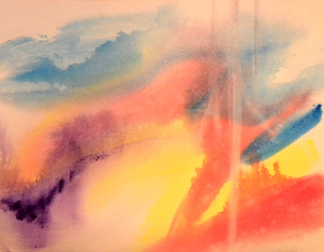
What do I mean by “exploiting” qualities unique to watercolor? Here you can see many in a wet-on-wet practice page by Shelia.
- colors blend and fuse into others
- one pigment runs through another, picking up color changes as it goes
- there are backruns and a wide variety of edges
- colors are glazed over others allowing you to see both simultaneously
- These effects are all visually pleasurable and can be exploited as you develop your painting.You may enjoy some of these effects in the early stages of your painting but as you finish it you find you are weakening it, making it nice or making it right. By the time you have completed it you have lost something that was magical.
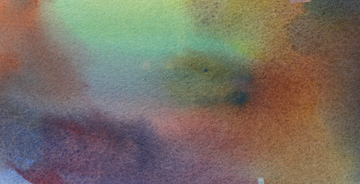 Here are some of the wonderful effects that are watercolor.
Here are some of the wonderful effects that are watercolor.
These are the kinds of things e unique to watercolor you may want to make happen . Not only make happen but allow them to be part of the painting, and yet still allow you to tell your story.
Most of them travel with the physical properties of water.
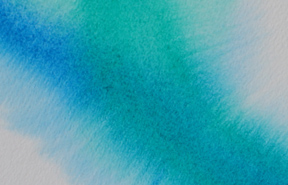 Colors can shift from one to another by manipulating the flow of water and color (as on the right). Hold your paper up and let the one color stroke merge with the next one, because water goes down hill.
Colors can shift from one to another by manipulating the flow of water and color (as on the right). Hold your paper up and let the one color stroke merge with the next one, because water goes down hill.- Pigments can veil one color letting the eye perceive two simultaneously (by glazing) as you see in the image above.
- A damp area wicks to it water from an adjacent wetter area. Backruns, splotches and blooms can be unwanted accidents or they can be used
 to develop interest and texture as shown in the close up on the right. It all depends on whether you knew that your brush was infusing the page with more water as the painted area had started to set (the shine was off of it). Or you just forgot to blot your brush. See photo to the right.
to develop interest and texture as shown in the close up on the right. It all depends on whether you knew that your brush was infusing the page with more water as the painted area had started to set (the shine was off of it). Or you just forgot to blot your brush. See photo to the right. - You can force runs in unimportant areas as in The Planter below, left.

To do this, and still tell your story, let most of the exciting watercolor things happen in the the less important sections as I am trying to do in this begonia painting.

You can see the fun I am having in the unimportant areas. Now the question to myself is how little I can do to the flowers to finish telling my story and still keep it loose.
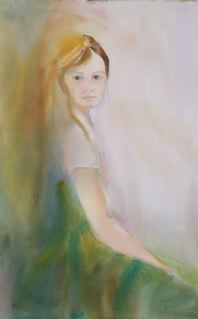 Here is another of a figure. I had several soft background glazes and had painted her face and arm. After having the painting pinned up for a while, I realized I didn’t really want to tell you about where she was sitting. I am interested in having her head and arm emerging from the background.
Here is another of a figure. I had several soft background glazes and had painted her face and arm. After having the painting pinned up for a while, I realized I didn’t really want to tell you about where she was sitting. I am interested in having her head and arm emerging from the background.
I wet the painting (submerged it in water for a few minutes; held it up until it stopped dripping) and then brushed colors into colors, working upright on an easel, until I was pleased with the movement of gold from her hair into the background and the darker greens under her arm.
Now that I have been studying it for a while I have decided to hint at her collar and shirt on our right (not too much or I am over finishing) and am going to repeat a suggestion of the green on the upper right. I will post it at the bottom when it is finished.

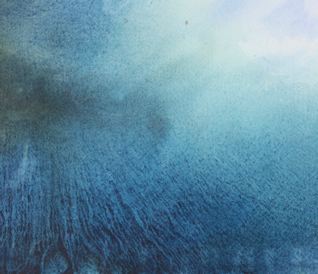 Here is one that was a pour, trying to develop a good wave and let the watercolor happenings described above occur in the outer edges. On the right, you can see how the clear dye color of pthalo blue is cutting through the more sedimentary ultramarine blue.
Here is one that was a pour, trying to develop a good wave and let the watercolor happenings described above occur in the outer edges. On the right, you can see how the clear dye color of pthalo blue is cutting through the more sedimentary ultramarine blue.
To give it a focus, I painted in a fishing boat – one I hoped would be sturdy enough to handle such weather. There is power in this watercolor development that is created by the handling of the medium.
In a class where I wanted to teach the differences between the dye or stain colors and the sedimentary I used this simple subject of an autumn farm.
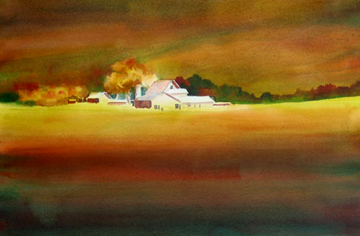 This too is watercolor. The dark at the bottom is pthalo green (dye) glazed over with Indian red (sedimentary). The Indian red is glazed over perinone orange in the middle of the field and quinacridone gold (clear) is glazed over cadmium yellow up by the farm house. Similar mainly sedimentary glazes are over warm undercolor on the hillside behind the house.
This too is watercolor. The dark at the bottom is pthalo green (dye) glazed over with Indian red (sedimentary). The Indian red is glazed over perinone orange in the middle of the field and quinacridone gold (clear) is glazed over cadmium yellow up by the farm house. Similar mainly sedimentary glazes are over warm undercolor on the hillside behind the house.
Without losing your focus, try to PLAY more in the out of focus areas, seeking out more ways you can exploit watercolor.
Whatever you do, enjoy exploiting your medium to make your watercolor painting more pleasurable to you.
Caroline
